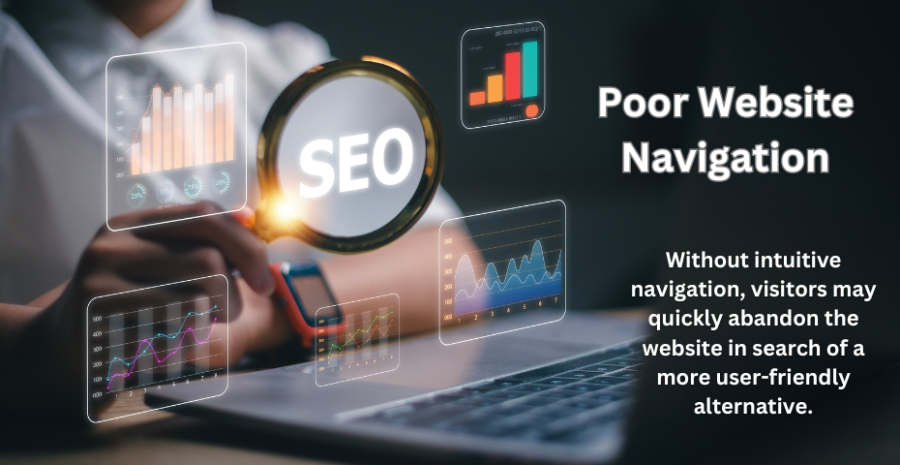
Avoid These 12 Overlooked Website Mistakes to Safeguard Your Business.

Introduction:
In today's digital landscape, a website serves as the cornerstone of a business's online presence, acting as a virtual storefront and primary point of interaction with customers. However, despite the critical role that websites play in driving business success, many entrepreneurs and businesses inadvertently overlook common mistakes that can undermine their online effectiveness.
From poor user experience to ineffective SEO strategies, these overlooked website mistakes have the potential to harm businesses in subtle yet significant ways. In this exploration of website pitfalls, we delve into the often underestimated errors that businesses make when crafting their online presence. By identifying and addressing these overlooked mistakes, businesses can optimize their websites to better serve their audience, enhance brand credibility, and ultimately drive growth and profitability.
Join us as we uncover these hidden obstacles and provide actionable insights to help businesses avoid common pitfalls and maximize the impact of their online presence.
1. Neglecting Mobile Optimization:

With a growing number of users accessing websites from mobile devices, overlooking mobile optimization can result in a poor user experience and lost opportunities for engagement. Neglecting mobile optimization is a critical oversight that can significantly harm a business's online presence. With the proliferation of smartphones and tablets, a large portion of website traffic now originates from mobile devices.
Failing to optimize for mobile leads to a subpar user experience, as websites may appear distorted, difficult to navigate, or slow to load on smaller screens. This poor user experience often results in high bounce rates, lost conversions, and diminished credibility. Moreover, search engines prioritize mobile-friendly websites in their rankings, meaning that neglecting mobile optimization can also negatively impact a website's visibility and search engine performance.
To avoid these pitfalls, businesses must prioritize mobile optimization by implementing responsive design, optimizing page load speed, and ensuring seamless navigation across all devices. By catering to the needs of mobile users, businesses can enhance user satisfaction, increase engagement, and ultimately drive growth and success in the digital landscape.
2. Poor Website Navigation:

Complex navigation structures can frustrate visitors and lead to high bounce rates. Streamlining navigation with clear menus and intuitive pathways enhances user experience and encourages exploration. Poor website navigation is a common yet detrimental mistake that can hinder user experience and impede business success online.
Complex navigation structures, cluttered menus, and unclear pathways make it difficult for visitors to find the information they seek, leading to frustration and high bounce rates. Without intuitive navigation, visitors may quickly abandon the website in search of a more user-friendly alternative. Additionally, poor navigation undermines the effectiveness of marketing efforts and reduces the likelihood of conversions, as users struggle to navigate through the sales funnel.
To mitigate this issue, businesses must prioritize streamlined navigation with clear menus, logical categories, and prominent calls-to-action. By enhancing website navigation, businesses can improve user satisfaction, increase engagement, and ultimately drive conversions and revenue.
3. Ignoring Page Load Speed:

Slow-loading pages can drive users away and negatively impact search engine rankings. Optimizing page load speed through image optimization, caching, and minification improves user satisfaction and retention. a website's performance and user experience. In today's fast-paced digital landscape, users expect instant access to information, and slow-loading pages can frustrate visitors and lead to high bounce rates.
Moreover, search engines penalize websites with slow load times, resulting in lower rankings and reduced visibility in search results. By neglecting page load speed optimization techniques such as image compression, browser caching, and minimizing HTTP requests, businesses risk losing potential customers and revenue.
To address this issue, businesses must prioritize page load speed optimization to deliver a seamless and responsive browsing experience for users. By improving page load speed, businesses can enhance user satisfaction, increase engagement, and ultimately drive conversions and business growth.
4. Lack of Clear Call-to-Action (CTA):
.png)
Failing to include compelling CTAs throughout the website diminishes conversion opportunities. Clearly defined CTAs guide users toward desired actions, such as making a purchase or contacting the business. The absence of clear call-to-action (CTA) elements on a website is a missed opportunity that can significantly hinder conversions and business growth.
Without clear prompts guiding visitors on what actions to take next, such as "Sign Up Now" or "Shop Now," users may feel directionless and unsure of how to engage with the website. This lack of direction can lead to missed opportunities for lead generation, sales, and other desired outcomes. Businesses must strategically place compelling CTAs throughout their website, making them prominent and easily accessible to visitors.
By implementing clear and persuasive CTAs, businesses can effectively guide users through the conversion process, encouraging them to take action and move further along the sales funnel. Ultimately, incorporating clear CTAs can improve user engagement, increase conversions, and drive business success.
5. Overwhelming Visitors with Cluttered Design:

Excessive elements, crowded layouts, and distracting visuals can overwhelm visitors and detract from the website's message. Embracing minimalism and whitespace creates a clean, visually appealing design that enhances readability and user engagement. Overwhelming visitors with a cluttered website design is a common yet detrimental mistake that can drive users away and harm business success.
When a website is cluttered with excessive elements, such as crowded layouts, distracting visuals, and too much text, it creates a chaotic and disorganized user experience. Visitors may feel overwhelmed and struggle to find the information they need, leading to frustration and high bounce rates. A cluttered design also detracts from the website's message and undermines the credibility of the business.
To avoid this pitfall, businesses must prioritize simplicity and clarity in their website design, focusing on essential elements and whitespace to create a clean and visually appealing layout. By decluttering the design, businesses can improve user engagement, enhance readability, and convey a professional image that instills trust and confidence in visitors.
6. Neglecting SEO Basics:

Ignoring fundamental SEO practices, such as optimizing meta tags, headings, and image alt text, limits the website's visibility in search engine results. Implementing SEO best practices improves organic search rankings and increases traffic. Neglecting SEO basics is a critical mistake that can limit a website's visibility and hinder its ability to attract organic traffic.
Fundamental SEO practices, such as optimizing meta tags, headings, and image alt text, play a crucial role in improving search engine rankings and driving targeted traffic to the website. Without proper optimization, websites may struggle to rank competitively in search engine results pages, resulting in reduced visibility and missed opportunities for attracting potential customers.
Additionally, neglecting SEO basics can prevent websites from capitalizing on valuable search queries related to their products or services, ultimately impacting their bottom line. To avoid this oversight, businesses must prioritize SEO optimization by implementing best practices and staying abreast of algorithm updates and industry trends. By optimizing for search engines, businesses can increase their online visibility, reach their target audience, and drive more qualified traffic to their website, ultimately leading to improved business success.
7. Inconsistent Branding and Messaging:

Incoherent branding and messaging across the website can confuse visitors and erode brand identity. Maintaining consistency in design, tone, and messaging strengthens brand recognition and fosters trust. Inconsistent branding and messaging can undermine a business's credibility and erode brand identity, hindering its ability to connect with its target audience effectively.
When branding elements such as logos, colors, and typography vary across different channels and platforms, it creates confusion and dilutes the brand's recognition and memorability. Inconsistent messaging further compounds the issue by conveying mixed or conflicting information about the brand's values, products, or services. This inconsistency can erode trust and loyalty among customers, making it challenging for businesses to establish a strong and cohesive brand identity.
To avoid this pitfall, businesses must ensure consistency in branding and messaging across all touchpoints, including the website, social media, advertising, and marketing materials. By presenting a unified brand image and delivering a consistent message, businesses can strengthen brand recognition, foster trust, and build lasting relationships with their audience.
8. Failing to Regularly Update Content:

Outdated content can convey a lack of credibility and relevance to visitors. Consistently updating content with fresh insights, news, and offerings demonstrates expertise and keeps visitors engaged. Failing to regularly update content on a website is a common yet significant oversight that can negatively impact its relevance, credibility, and search engine rankings.
Outdated content may convey a lack of freshness and relevance to visitors, leading to reduced engagement and diminished trust in the brand. Moreover, search engines prioritize fresh and high-quality content in their rankings, meaning that neglecting updates can result in lower visibility and organic traffic. By regularly updating content with new insights, information, and offerings, businesses can demonstrate their expertise, keep visitors engaged, and maintain their competitive edge in the online landscape.
Additionally, fresh content provides opportunities to target new keywords, expand reach, and address emerging trends, ensuring that the website remains relevant and resonant with its target audience over time. To avoid this pitfall, businesses must prioritize content updates as part of their ongoing website maintenance strategy, leveraging analytics and user feedback to inform their content creation efforts and drive continued growth and success.
9. Overlooking Accessibility:

Inaccessible websites exclude users with disabilities and may violate accessibility regulations. Ensuring compliance with accessibility standards enhances inclusivity and broadens the website's reach. Overlooking accessibility on a website is a critical mistake that can exclude users with disabilities and hinder their ability to access information and engage with the content.
Failure to comply with accessibility standards not only limits the website's reach but also may result in legal liabilities and damage to the brand's reputation. Accessibility encompasses various aspects, including providing alternative text for images, ensuring keyboard navigation, and making content perceivable to users with visual or hearing impairments. By prioritizing accessibility, businesses demonstrate their commitment to inclusivity and ensure that all users, regardless of their abilities, can access and interact with the website effectively.
Moreover, accessible websites often benefit all users by improving usability, enhancing user experience, and increasing engagement. To avoid overlooking accessibility, businesses must adhere to accessibility guidelines and standards, conduct regular audits, and incorporate accessibility considerations into their website design and development processes from the outset.
10. Neglecting Security Measures:

Inadequate security measures, such as outdated software or weak passwords, expose the website to potential breaches and data theft. Implementing robust security protocols safeguards sensitive information and preserves customer trust. Neglecting security measures on a website is a grave oversight that can expose sensitive data to cyber threats and compromise user trust.
With the prevalence of cyberattacks and data breaches, failing to implement robust security protocols leaves websites vulnerable to hacking, malware infections, and unauthorized access. The consequences of security breaches can be severe, resulting in financial losses, reputational damage, and legal liabilities for businesses. Neglecting security measures not only puts the website at risk but also jeopardizes the safety and privacy of users' personal information.
To mitigate these risks, businesses must prioritize security by implementing measures such as SSL encryption, regular software updates, and strong password policies. Additionally, conducting security audits and penetration testing can help identify vulnerabilities and proactively address potential threats. By prioritizing security, businesses can safeguard their website, protect sensitive data, and preserve customer trust in an increasingly digital world.
11. Disregarding Analytics and Insights:

Neglecting to monitor website performance through analytics overlooks valuable data insights. Regularly analyzing metrics such as traffic, bounce rate, and conversion rates enables informed decision-making and continuous improvement. Disregarding analytics and insights on a website is a missed opportunity that can hinder businesses from making informed decisions and optimizing their online performance.
Analytics provide valuable data on user behavior, traffic sources, and conversion rates, offering insights into what is working well and where improvements are needed. Failing to monitor and analyze this data means businesses are operating blindly, without the knowledge needed to identify strengths, weaknesses, and areas for growth. By disregarding analytics, businesses miss out on valuable opportunities to refine their strategies, enhance user experience, and drive meaningful results.
Regularly monitoring key metrics allows businesses to identify trends, track progress towards goals, and make data-driven decisions that maximize their online effectiveness. To avoid this oversight, businesses must prioritize analytics and insights, leveraging tools such as Google Analytics to gain valuable insights into their website performance and make informed decisions to drive business success.
12. Lack of Contact Information:

Hiding or omitting contact information makes it difficult for visitors to reach the business, potentially leading to missed opportunities for inquiries or sales. Displaying clear contact information instills confidence and facilitates communication with customers. Lack of contact information on a website is a critical oversight that can hinder communication with potential customers and impede business growth.
When visitors cannot easily find contact details such as phone numbers, email addresses, or physical addresses, they may perceive the business as untrustworthy or inaccessible. This lack of transparency can lead to missed opportunities for inquiries, sales, and valuable customer interactions. Additionally, omitting contact information undermines the credibility of the business and diminishes its professional image.
To address this issue, businesses must ensure that contact information is prominently displayed on their website, making it easy for visitors to reach out and connect. By providing clear and accessible contact details, businesses can foster trust, facilitate communication, and create opportunities for meaningful engagement with their audience.
In conclusion:
Avoiding the 12 overlooked website mistakes outlined in this blog is crucial for safeguarding the success and reputation of your business in the digital age. By addressing these common pitfalls, businesses can enhance their online presence, improve user experience, and drive meaningful results.
Prioritizing mobile optimization, streamlined navigation, and fast page load speed ensures that visitors can access and engage with your website seamlessly across devices. Clear call-to-action elements, clutter-free design, and consistent branding reinforce your messaging and guide users towards desired actions, boosting conversions and customer satisfaction.
Embracing SEO best practices, regular content updates, and accessibility standards enhances visibility, relevance, and inclusivity, positioning your website for success in search engine rankings and user engagement. By prioritizing security measures, analytics insights, and contact information, businesses can foster trust, transparency, and meaningful connections with their audience.
In essence, by avoiding these overlooked website mistakes, businesses can fortify their online presence, strengthen their brand reputation, and ultimately achieve their business goals with confidence and success.

About: Andries vanTonder
45 years selfemployed
He is a Serial Entrepreneur, an Enthusiastic supporter of Blockchain Technology and a Cryptocurrency Investor
Find me: Markethive Profile Page | My Twitter Account | My Instagram Acount | and my Facebook Profile.
